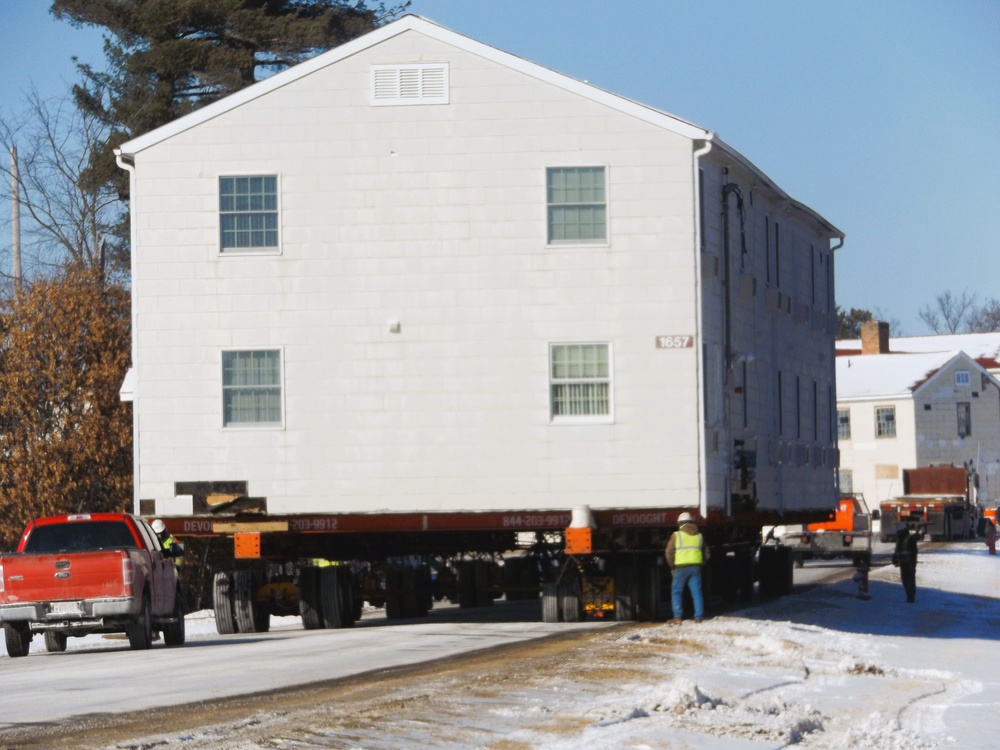Building movers chalked up a full second movement of a World War II-era barracks building Feb. 12-13 as they moved it from the installation’s 1600 block on the cantonment area to the 500 block for temporary placement.
The first of the five 83-year-old buildings was moved Jan. 22. A total of five barracks buildings on the installation cantonment area’s 1600 block are being moved during January and February 2025 while the ground is frozen, Army Corps of Engineers officials said.
Devooght Building Movers of Manitowoc, Wis., is the contractor doing the building moving with wheels and remote control powered by a generator. These buildings, originally constructed in 1942 ,will eventually be reset at another area of the post so new construction can begin in their current location on two new officer quarters buildings.
Fort McCoy Directorate of Public Works master planners said a plan was previously worked out with the U.S. Army Corps of Engineers for the contractor to move the five old barracks buildings to the 500 block of Fort McCoy in this move. The buildings will be temporarily set in that block until new locations are determined.
As stated in a previous news article, four other barracks buildings also were moved from the 1600 block to other post areas in 2023 by a different contractor. Those four buildings are now operational in their new locations in the 1700, 1800, and 2100 blocks on the post.
In 2023 during the first barracks move operations, that was the first time an effort like that took place at Fort McCoy, Fort McCoy officials said.
Looking back to 1942, when the “new camp” became the center of then-Camp McCoy, these barracks buildings were considered state-of-the-art facilities. On Aug. 30, 1942, during a large open house to show the public all of the new buildings in the “new camp” at McCoy, more than 50,000 people visited.
“The public came. The public saw. The public praised,” states a news article in the Sept. 14, 1942, edition of The Real McCoy newspaper at Camp McCoy. “Yes Soldiers, nearly 50,000 persons stared with pop-eyed amazement at the wonders of new Camp McCoy last Sunday when they came as guests in answer to the open house invitation of Camp Commander Col. George M. MacMullin.
“Roads, from every direction from miles around, were jammed with motor vehicles. Our visitors came in automobiles, trucks, taxicabs, and buses — an endless stream — almost bumper to bumper,” the article states. “According to Provost Marshal Capt. Hans R. Biegel, former sheriff of this county, it was the largest crowd of visitors he had ever seen. Expressions of delight at the beautiful buildings were heard on all sides. High praise was sounded at the efficient manner in which traffic was handled through the immense camp area. Not a word of dissatisfaction came from anyone. Members of the post and 732nd Military Police units acted as escorts and street guides were showered with compliments.”
Another article from the Aug. 28, 1942, edition of The Real McCoy newspaper further look at the post’s new cantonment area.
“One of the largest and most modern Army camps, the new Camp McCoy, located further inland than the old one, will offer its personnel the best that any Army camp can afford with its two spacious service clubs, its numerous theaters with its large seating capacity, its chapels, and its unlimited recreational facilities,” the article states.
“The greatest innovation to the personnel no doubt will be the opportunity to dwell in the most modern barracks with the privilege of taking a shower in one’s own home instead of hiking to distant points to cleanse oneself,” the article states.
As these facilities will see a revamping in the future, their movement also opens the old location up for the completion of the fiscal year 2024-funded $55.75 million Collective Training Officers Quarters Project.
The project description in the contract for that new project states the plan is to build the two buildings based on the standard layout depicted in the Operational Readiness Training Complex.
“This facility is required to replace antiquated World War II-era wood transient training officer quarters currently being utilized to train Soldiers during major exercises, annual training, battle assembly, and mobilization at Fort McCoy,” the description states. “This facility will be designed with the ability to be winterized or deactivated during the winter months. When Fort McCoy is not stood up as a mobilization platform, its primary mission is to support the seasonal requirements of training … Army Reserve Soldiers. In order to conserve as much energy as possible, while also decreasing the funding necessary to field extended utility costs, this building will be deactivated when it is not being used for training.”
Building moves will continue as conditions permit, officials said.
Fort McCoy’s motto is to be the “Total Force Training Center.” Located in the heart of the upper Midwest, Fort McCoy is the only U.S. Army installation in Wisconsin.
The installation has provided support and facilities for the field and classroom training of more than 100,000 military personnel from all services nearly every year since 1984.
Learn more about Fort McCoy online at https://home.army.mil/mccoy, on Facebook by searching “ftmccoy,” on Flickr at https://www.flickr.com/photos/fortmccoywi, and on X (formerly Twitter) by searching “usagmccoy.”
Also try downloading the My Army Post app to your smartphone and set “Fort McCoy” or another installation as your preferred base. Fort McCoy is also part of Army’s Installation Management Command where “We Are The Army’s Home.”
| Date Taken: | 02.17.2025 |
| Date Posted: | 02.18.2025 00:31 |
| Story ID: | 490921 |
| Location: | FORT MCCOY, WISCONSIN, US |
| Web Views: | 23 |
| Downloads: | 0 |
PUBLIC DOMAIN

This work, Workers successfully move second World War II barracks at Fort McCoy; preparations under way to move third building, by Scott Sturkol, identified by DVIDS, must comply with the restrictions shown on https://www.dvidshub.net/about/copyright.








